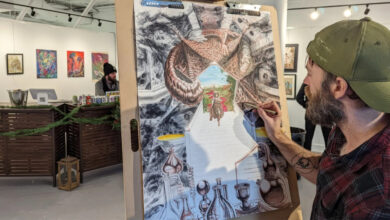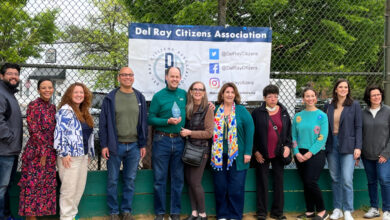Discovering Alexandria’s Untold History One Privy at a Time
Alexandria's rich history is well known but there is even more to discover, thanks to the privy digging efforts of Tom Levielle and his friends.

the country. Tom Levielle (left) is next to the curator of the competition (Mike Newman). Tom won 3rd place.
(All photos courtesy of Tom Levielle)
Alexandria, VA – Alexandria’s rich history is well known but there is even more to discover, thanks to the privy digging efforts of Tom Levielle and his friends. Since 2011, Levielle has investigated over 500 privies in the area, sharing his recoveries with homeowners and fans online.
Privy digging consists of locating and exploring the contents of defunct outhouse vaults. While that might give people pause, after a hundred years or so, it’s just dirt. The reason for privy digging is to salvage antique bottles and common household artifacts from the past.
Tom’s interest in privy digging started simply enough. “I used to go prospecting in Northern Virginia and while panning one day I found a really old bottle,” he says. “I took it home and looked it up. It was a beer bottle local to Washington, D.C., and had a little picture of a fox on it. It was very interesting.”
(All photos courtesy of Tom Levielle)
His interest quickly grew. “My dad told me about this fishing spot he had, and to get there he had to walk past a bank that had a whole bunch of old glass just sticking out. One day we went out there with shovels and that was it. I fell in love. The natural progression from just getting into it was that then we would dig around in the woods and wherever we could, and that turned into knocking on folks’ doors to get permission to look through the old privies.”
Alexandria is a natural venue for exploring backyard privies. Tom says, “In Virginia, if a house was typically in a city setting and older than 1915, spanning back into the 1700s, they would have had outdoor plumbing, and because the City didn’t have regulated trash pick-up, the privy became the trash can too.”
(All photos courtesy of Tom Levielle)
About first digging in Alexandria, Tom says, “It was in 2012, behind a Captain’s house on Queen Street. We dug a 6-foot round, 24-foot deep brick lime structure that had artifacts dating from 1915 back to 1830. Hundreds of bottles, ceramic, porcelain, anything not organic would still be there. Toothbrushes, things children would play with, bottles, ceramics, all went in there whole or we found enough pieces that we were able to glue them back together.”
Tom’s favorite found item, he says, “was a bottle in Alexandria that had the name of the soda bottler on one side and a shield and eagle on the other.”
(All photos courtesy of Tom Levielle)
(All photos courtesy of Tom Levielle)
(All photos courtesy of Tom Levielle)
How do Tom and friends go about privy digging? After getting permission from the homeowner, the real work begins. “We use an instrument called a probe,” he says, “which is a spring steel rod, to locate where (the privies) are and then we lay out our tarps and trash cans.”
Then the digging begins. “We hope that when we look in them that there would be a layer of artifacts that didn’t get cleaned out. Sometimes they are empty and sometimes they have stuff in them.”
(All photos courtesy of Tom Levielle)
After the job is complete, they restore everything to the way it was before or even better. “A lot of times (abandoned privies) cause the backyard area to sink, and we’re able to fix that. We fill it in, cap with concrete, and it no longer sinks for the homeowner.”
The treasures privies hold tell stories of how life was back in past times, stories not found in history books. “You find out where they got their soda, medicines for kids, what butcher shops they shopped at. When you pull this stuff out of the ground and clean it up, you see where they bought a bottle or even their dishes and silverware. It’s all in the privies.
“When you’re digging in Alexandria,” he adds, “it’s solving a mystery. And every house in Old Town has one of these in their backyard that we can explore. For the love of history and for fun.”
If you’re interested in finding out what type of history is in your backyard, contact [email protected] or 757-508-6985.
ICYMI: FOR SALE: Alexandria House of History on Cameron Street













nobody is “discovering” any history here. this is looting. plain and simple. they’re digging this stuff up and keeping it for themselves and/or selling it for a profit. this is an irreplaceable loss to our collective heritage and a terrible precedent to set. the zebra should be ashamed for publishing this. did you consider contacting the city archaeologist or the office of historic alexandria for comment before posting this article? has the looter here ever contacted the city archaeologist? we’re blessed with one of the only local archaeology protection codes in the country and ripping these artifacts out of the ground without proper scientific study or documentation is the exact opposite of that.
Most of the time, if not for hobbyist archaeologist, the privy location simply gets covered up. So whats more of an irreplaceable loss; a privy being covered by a new building or parking lot, never to be seen again, or a hobbyist finding the artifacts, cherishing them for a lifetime, and sharing the finds with the community?
if a building or parking lot in alexandria is going to be large enough to disturb a privy, that project probably requires a building permit from the city of alexandria. if it requires a building permit from the city of alexandria, then that project probably requires approval by the city archaeologist: https://www.alexandriava.gov/historic/archaeology/default.aspx?id=28146.
if that privy is to be damaged or lost, it requires study by trained, professional archaeologists who are required to publish their findings. alexandria archaeology, the city’s archaeology department, has made most of their reports available online: https://www.alexandriava.gov/historic/archaeology/default.aspx?id=46284. please tell me, where can i find the professional publications of mr. levielle? did he take field notes? photographs? measured drawings? where can i find his museum? what are its operating hours? are his collections kept in a facility that meet professional standards for the curation of archaeological artifacts? what were his research questions? did he do archival background research prior to digging? what did he learn from his excavations? was it enough to fill up a report consisting of hundreds of pages of text?
so the answer to your question, “which is more of an irreplaceable loss”, should be perfectly clear. if you don’t touch it, nothing will be lost. it’s been in the ground for 100 years and will still be there in 100 more. if it will be impacted by a construction project, the city has a law on the books to document and preserve that resource because they are precious and irreplaceable and important to all alexandrians, not just a small club of bottle hunters. they’re not saving this archaeological resource from obscurity; they’re destroying it.
the best course of action for an archaeological resource is to leave it alone. if you can’t leave it alone, there’s a process in place to handle it.
Lois and Richard of Studio Antiques,
We agree. As antiques dealers in Alexandria for the past 40 years, we have always respected the city’s dedication to preserving it’s rich history and have declined to buy or sell artifacts that might be of importance to Alexandria archeology Often the smallest shard and it’s location in a dig will provide insight to the city’s history. Contact the city’s professional historians before you allow someone to dig in your backyard.
contact https://www.alexandriava.gov/historic/archaeology/default.aspx?id=39208
I read your story with amazement because this spring a well on our property in Old Town was found … actually not only on our property, but also my neighbor’s. The well literally was half on our side, half on his. As the Chair of the Alexandria Archeological Commission, I knew the responsible next step was to contact the city’s archaeology department (703-746-4399). We were all surprised when they inspected the well to discover that it was from the 1820’s and is the second known well in the city to cross 2 property lines that had structures on them at that time. This was very intriguing to staff and brought new insight: neighbors shared resources even back then.
Every property owner in Old Town who makes a discovery such as this should reach out to Alexandria Archaeology. Their job is to respond to questions about the city’s archaeological heritage. They are a great resource for all Alexandrians. Collecting bottles may be a fun hobby, but as a property owner in the Old and Historic District of Old Town the responsible action is to add to the collective understanding of our city’s past.
I read your story with amazement because this spring a well on our property in Old Town was found … actually not only on my property, but also my neighbor’s. The well literally was half on our side, half on his. As the Chair of the Alexandria Archeological Commission, I knew the responsible next step was to contact the city’s archaeology department (703-746-4399). We were all surprised when they inspected the well to discover that it was from the 1820’s and is the second known well in the city to cross 2 property lines that had structures on them at that time. This was very intriguing to staff and brought new insight: neighbors shared resources even back then.
Every property owner in Old Town who makes a discovery such as this should reach out to Alexandria Archaeology. Their job is to respond to questions about the city’s archaeological heritage. They are a great resource for all Alexandrians. Collecting bottles may be a fun hobby, but as a property owner in the Old and Historic District of Old Town the responsible action is to add to the collective understanding of our city’s past.